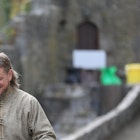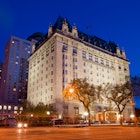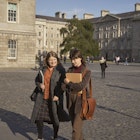

Northern Irelandâs second city is fast becoming one of the countryâs cultural hotspots. It was given a stylish makeover for its stint as UK City of Culture in 2013, and plays host to crowd-pulling annual events such as the City of Derry Jazz Festival, the Foyle Film Festival and the famous Halloween Carnival â the largest street party in Ireland.
Itâs a city with a long and fascinating, if troubled, history but a youthful and optimistic population. In the words of Will Kelly, one of the celebrated Bogside Artists: âDerry is a big city with the ambience and character of a village. The sense of freedom of the people, young and old, is truly infectious. You could pick any Derryman or woman and put them on stage for their wit alone. In short, Derry is fun.â

Day one
Morning
Your first day here is an opportunity to get to grips with the history of this intriguing city. Start with a visit to the striking, neogothic Guildhall, more than a hundred years old and famous for its magnificent stained glass windows. An exhibition explains the 17th-century Plantation of Ulster, a seminal event that has shaped the history of Ireland ever since. Walk across Guildhall Square â if itâs the first Saturday of the month, you can browse among the artisan food stalls of the Walled City Market â and enter the walled city itself.
Allow an hour or two to fully appreciate the Tower Museum, whose exhibits lead you through the cityâs history from the founding of St Columbaâs monastery in the 6th century to the 1960s Battle of the Bogside. And donât miss the Armada Shipwreck display, which showcases the treasures found on the remains of a Spanish galleon that was wrecked off the Antrim coast in 1588.
Cafe del Mondo, a typically bohemian Derry cafe, is a good place to grab a spot of lunch. Itâs in the craft village, a covered complex of craft shops and galleries next to the museum.
Afternoon
Derry is the only city in Ireland whose medieval city walls have survived largely intact, and completing the 1.5km circuit of the parapet is a highlight of any visit â there are access stairs at the Magazine Gate, just west of the craft village.
The walls were built in 1619 to defend English and Scottish settlers from Irish rebels, and played a crucial role in allowing the city to withstand the notorious Siege of Derry in 1688-89.
Walking clockwise around the walls you pass the modern façade of the Millennium Forum, the cityâs main entertainment venue, before the view opens up to the southeast across the River Foyle. Close under the wall is the Fountain housing estate, the last significant Protestant community on the western bank of the Foyle, while inside the walls rises St Columbâs Cathedral.
Continue around the southern stretch of wall to the Double Bastion at the southwestern corner, home to Roaring Meg, the most famous of the cannons used during the Siege of Derry. The next section of wall is known as the Grand Parade, and offers an excellent view of the murals painted by the Bogside Artists.

Descend from the walls at the Butchers Gate and walk along Butcher St to the Diamond, the central square of the walled city, with its ornate war memorial. The elaborately turreted building on the southeast corner is Austinâs, the world's oldest independent department store, established in 1830, a good place to shop for Irish linen.
Head a block south to visit St Columbâs Cathedral, the cityâs oldest surviving building. Dating from 1633, it was the first post-Reformation church to be built in Ireland, and houses numerous interesting historical relics including the four huge padlocks used to secure the city gates in the 17th century.
Just around the corner from the cathedral gate is the Centre for Contemporary Art, where you can learn about emerging artists in Northern Ireland and browse changing exhibitions of art from around the world.

Evening
As evening falls, wander down to the waterfront of the River Foyle, and stroll across the Peace Bridge, an elegantly curving footbridge that was completed in 2011. It leads to Ebrington Square, a former British army barracks that has been reinvented as a public space â concerts and other cultural events are held here throughout the year (check whatâs on at the tourist office).
A short walk south of the square youâll find Brownâs Restaurant, one of Derryâs top eateries and the ideal place for dinner â best to book at least a week in advance. Afterwards you can wander back across the floodlit Peace Bridge to enjoy a drink and some music at Sandinoâs Cafe Bar, a famously friendly nightspot with an alternative vibe.
Day two
Morning
Day two and time for a closer look at Derryâs more recent history, notably its part in the Troubles that afflicted Northern Ireland from the late 1960s until 1998, with a visit to the Bogside, the district that lies to the north of the walled city.

During your walk along the city walls you will have seen the huge mural paintings that adorn the gable ends of houses along Rossville St. Painted mostly between 1997 and 2001 by a group of three local men, they are known collectively as the Peopleâs Gallery and commemorate key events in the Troubles. You can visit the murals yourself, or better still take a tour guided by the Bogside Artists themselves (book in advance).
In the midst of the murals is the Museum of Free Derry, which chronicles the history of the Bogside, the civil rights movement and the events of Bloody Sunday through photographs, newspaper reports, film clips and the accounts of first-hand witnesses.
Afterwards, take a stroll along the waterfront walkway on the west bank of the River Foyle as far as Sainsburyâs, where a bronze sculpture of an emigrant family commemorates the fact that 19th-century Derry was one of the main ports of emigration to the USA.
Return along the walkway for lunch at PykeânâPommes, a gourmet burger bar that serves Derryâs finest street food, trading out of a converted shipping container.

Afternoon
After lunch, take the opportunity to explore a tiny bit of neighbouring County Donegalâs scenic Inishowen peninsula. Buses depart hourly (Monday to Saturday) from the Guildhall to the seaside village of Buncrana, 35 minutes to the northwest, where you can walk the coastal path past three ruined castles, or sip a pint of Guinness in one of the local pubs (even the Sunday timetable allows you three hours in the village).
Evening
Back in the city, plan on dinner at the Custom House, a smart and stylish modern brasserie, before crawling the pubs along Waterloo St, just beneath the city walls. Peadar OâDonnellâs is a good bet for a traditional Irish music session, while Masonâs is the place to catch up-and-coming local rock bands.
Explore related stories



 FilmIrish people left bewildered by the trailer for "Wild Mountain Thyme"
FilmIrish people left bewildered by the trailer for "Wild Mountain Thyme"Nov 12, 2020 ⢠2 min read
 FilmSee the Irish castle where Matt Damon and Ben Affleck's new movie is being filmed
FilmSee the Irish castle where Matt Damon and Ben Affleck's new movie is being filmedOct 1, 2020 ⢠2 min read


 TV'The social side of Dublin is something you have to experience' - Normal People's Daisy Edgar-Jones
TV'The social side of Dublin is something you have to experience' - Normal People's Daisy Edgar-JonesApr 30, 2020 ⢠3 min read
 ArtA theatre designer is recreating famous artworks with her parents in lockdown
ArtA theatre designer is recreating famous artworks with her parents in lockdownApr 7, 2020 ⢠2 min read
 Wildlife & NatureWhy I hiked to the top of the Swiss Alps to play a gig last summer
Wildlife & NatureWhy I hiked to the top of the Swiss Alps to play a gig last summerApr 6, 2020 ⢠5 min read

